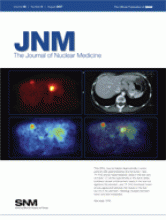SPECT vs. PET in graft infection: Burroni and colleagues review the gold standard of scintigraphy with radiolabeled white blood cells in vascular graft infection and the relative merits of PET and PET/CT in this indication.
Page 1227
PET/CT in vascular graft infection: Keidar and colleagues assess the effectiveness of 18F-FDG PET/CT in the diagnosis of vascular graft–related complications and in differentiation between graft and soft-tissue infection.
Page 1230

PET/CT in salivary cancer: Jeong and colleagues compare the prognostic and treatment-planning abilities of 18F-FDG PET/CT and contrast-enhanced CT in patients with high-grade salivary gland malignancies.
Page 1237


Novel PET tracer for GIST: Dimitrakopoulou-Strauss and colleagues describe PET studies with a 68Ga-bombesin analog and 18F-FDG in patients with gastrointestinal stromal tumors to investigate the effects of complementary receptor scintigraphy on diagnostic accuracy.
Page 1245
PET/CT in recurrent esophageal cancer: Guo and colleagues report on the diagnostic and prognostic roles of 18F-FDG PET/CT in patients with suspected recurrence of esophageal squamous cell carcinoma after definitive treatment.
Page 1251
Algorithms not interchangeable: Chen and colleagues provide data on the selection of reconstruction algorithms for 13N-NH3 PET estimation of quantitative myocardial blood flow.
Page 1259

Receptor effect in breast cancer PET: Mavi and colleagues investigate correlations between 18F-FDG uptake of primary breast cancer lesions and predictive and prognostic factors such as C-erbB-2, estrogen, and progesterone receptor states.
Page 1266
SPECT and rCBF in depression treatment: Kohn and colleagues use 99mTc-HMPAO SPECT to determine whether reversal of compromised regional cerebral blood flow in patients with major depressive disorder is dependant on the mode of antidepressant treatment.
Page 1273

18F-MPPF PET for longitudinal studies: Costes and colleagues assess the reliability and reproducibility of binding parameter quantification for this radiolabeled 5-HT1A receptor antagonist through a test–retest study over a long-term period.
Page 1279
Advances in Alzheimer's assessment: Matsuda provides an educational overview of the role of neuroimaging in Alzheimer's disease, with a special focus on the utility of statistical analyses in brain perfusion SPECT, PET, and MRI techniques.
Page 1289

Monitoring myocardial therapy: Taki and colleagues evaluate 99mTc-annexin-V uptake in a rat model of ischemia and reperfusion to determine whether postconditioning or ischemic preconditioning suppress myocardial cell damage or apoptosis.
Page 1301
18F-FDG and mitochondrial membrane potential: Smith and Blaylock report on in vitro research in breast tumor cells to determine how the loss of mitochondrial membrane potential in apoptosis influences 18F-FDG incorporation.
Page 1308
VEGF tumor imaging: Nagengast and colleagues describe the development of a radiolabeled humanized monoclonal antibody for noninvasive in vivo vascular endothelial growth factor visualization and quantification with 111In and 89Zr PET.
Page 1313

Lowered σ1 binding after therapy: van Waarde and colleagues compare early changes in 11C-SA4503 binding and 18F-FDG uptake in gliomas after chemotherapy to evaluate the potential of a radiolabeled σ1-ligand for response monitoring.
Page 1320

64Cu-bombesin analogs for preclinical PET/CT: Garrison and colleagues report on studies in a mouse model of prostate cancer to determine whether the CB-TE2A chelation system could significantly improve the in vivo stability of 64Cu-bombesin analogs.
Page 1327

Novel carrier modules in lymphoma: DeNardo and colleagues characterize the pharmacokinetics of selective high-affinity ligand molecules that show promise as effective radioisotope carriers for molecular-based imaging and treatment of lymphoma.
Page 1338

Imaging of melanoma metastases: Pham and colleagues describe mouse studies with a novel 123I-labeled molecule for SPECT imaging and staging of metastatic dissemination of melanoma tumors and the potential for therapeutic applications.
Page 1348

111In-trastuzumab and nuclear targeting: Costantini and colleagues evaluate the cytotoxicity and tumor-targeting properties of the monoclonal antibody trastuzumab modified with peptides harboring nuclear localization sequences and discuss the potential for radioimmunotherapeutic applications.
Page 1357

Whole-body parametric imaging: Gleisner and colleagues detail a method for pharmacokinetic modeling of distributions of 111In-labeled monoclonal antibodies on individual pixels of planar scintillation camera images.
Page 1369

Solid-phase 99mTc preloading: Misra and colleagues introduce a multimeric, small-molecule radiotracer with high affinity to prostate-specific membrane antigen and describe its production through a solid-phase conversion of sodium 99mTc-pertechnetate to a general-purpose, reactive form.
Page 1379
Chelate stability and 64Cu: Eiblmaier and colleagues explore the question of whether 64Cu localization to cell nuclei from internalizing, receptor-targeted radiopharmaceuticals is related to chelate stability.
Page 1390
Journal impact factors: Currie and Wheat provide a general description of journal impact factor statistics in peer-reviewed nuclear medicine literature and discuss the implications, advantages, and shortcomings of these increasingly referenced metrics.
Page 1397
ON THE COVER
68Ga-BZH3 may be helpful diagnostically in some patients with gastrointestinal stromal tumor. Here, 18F-FDG shows hyper metabolic areas in the liver and stomach, CT shows hypodensity in the same areas, bombesin shows enhancement clearly in the liver but slightly in the stomach, and 18F-FDG–bombesin fusion shows agreement between the tracers in the liver but not in the stomach. Histology revealed stomach tumor and liver metastasis.

See page 1248.







